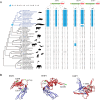Adaptive evolution of BMP4 as a potential mechanism for flipper forelimb changes in cetaceans
- PMID: 40407132
- PMCID: PMC12361908
- DOI: 10.24272/j.issn.2095-8137.2024.473
Adaptive evolution of BMP4 as a potential mechanism for flipper forelimb changes in cetaceans
Abstract
Vertebrate limbs have undergone profound morphological diversification, enabling adaptations to a broad spectrum of ecological niches. In marine mammals, the evolution of highly specialized flipper-like forelimbs represents a profound structural transformation associated with aquatic habitats. This adaptation has been hypothesized to result, in part, from the inhibition of interphalangeal cell apoptosis during limb development, although the underlying genetic mechanism remains poorly understood. This study investigated the evolutionary dynamics and functional consequences of three key bone morphogenetic protein genes, BMP2, BMP4, and BMP7, which regulate apoptosis in interphalangeal mesenchymal stromal cells during embryonic limb development to ensure proper differentiation of interphalangeal tissues. Comparative genomic analysis revealed significantly accelerated evolution for BMP4 and BMP7 in the cetacean ancestral lineage, with two positively selected sites (V79I and H247R) involved in cetacean-specific amino acid substitutions located in the TGF-β propeptide functional domain in BMP4. In vitro assays confirmed that cetacean-specific BMP4 mutations significantly disrupted normal cell apoptosis and proliferation and altered the transcription and protein expression of downstream apoptosis-related factors, including cytochrome c (Cyt c), BCL2 associated X, and B-cell lymphoma 2, within the BMP signaling pathway. The significant influence of BMP4 mutations on apoptotic inhibition highlights a potential role in the development of limb bud mesenchymal tissue and the emergence of the flipper forelimb phenotype in cetaceans.
脊椎动物的肢体形态在生物演化过程中经历了深刻的形态多样化改变,能够适应广泛的生态位。在海洋哺乳动物中,高度特化的鳍状前肢代表了与水生适应相关的深刻结构转变。有研究推测这种进化革新可能部分源于肢体发育过程中指间细胞凋亡的抑制,然而其潜在的遗传机制仍知之甚少。本研究聚焦于骨形态发生蛋白家族中的三个关键成员—— BMP2, BMP4和 BMP7的进化动力学和功能效应,该类基因通过调控胚胎期肢芽间充质细胞的调亡,来维持指间组织的正常分化。研究发现在鲸类祖先谱系中, BMP4和 BMP7在鲸类祖先支系中经历了显著的加速进化,其中BMP4蛋白的两个鲸类特异性氨基酸替换位点(V79I和H247R)位于TGFβ_propeptide功能域内,且受到强烈正选择作用。体外实验进一步证实,鲸类 BMP4的特异性突变不仅显著干扰了正常的细胞凋亡与增殖能力,而且影响了BMP信号通路下游关键凋亡相关因子(Cyt c, Bax, Bcl-2)的转录和蛋白表达。鲸类 BMP4的这一适应性进化及其特异性突变对细胞凋亡抑制的显著影响,暗示其在调控鲸类肢芽间充质组织的发育和鳍状前肢形态发生中的潜在作用。.
Keywords: BMP4; Cetaceans; Flipper limb; Functional change.
Conflict of interest statement
The authors declare that they have no competing interests.
Figures





Similar articles
-
Evolution of cetacean-specific conserved non-coding elements suggests their role in the limb changes during secondary aquatic adaptation.BMC Biol. 2025 Jul 16;23(1):216. doi: 10.1186/s12915-025-02300-0. BMC Biol. 2025. PMID: 40670992 Free PMC article.
-
Relaxed selection in evolution of genes regulating limb development gives clue to variation in forelimb morphology of cetaceans and other mammals.Proc Biol Sci. 2024 Oct;291(2032):20241106. doi: 10.1098/rspb.2024.1106. Epub 2024 Oct 9. Proc Biol Sci. 2024. PMID: 39378996
-
Breathing Air and Living Underwater: Molecular Evolution of Genes Related to Antioxidant Response in Cetaceans and Pinnipeds.J Mol Evol. 2024 Jun;92(3):300-316. doi: 10.1007/s00239-024-10170-3. Epub 2024 May 12. J Mol Evol. 2024. PMID: 38735005
-
Stage-specific DNA methylation dynamics in mammalian heart development.Epigenomics. 2025 Apr;17(5):359-371. doi: 10.1080/17501911.2025.2467024. Epub 2025 Feb 21. Epigenomics. 2025. PMID: 39980349 Review.
-
Management of urinary stones by experts in stone disease (ESD 2025).Arch Ital Urol Androl. 2025 Jun 30;97(2):14085. doi: 10.4081/aiua.2025.14085. Epub 2025 Jun 30. Arch Ital Urol Androl. 2025. PMID: 40583613 Review.
References
-
- Bejder L, Hall BK Limbs in whales and limblessness in other vertebrates: mechanisms of evolutionary and developmental transformation and loss. Evolution & Development. 2002;4(6):445–458. - PubMed
MeSH terms
Substances
LinkOut - more resources
Full Text Sources
